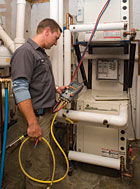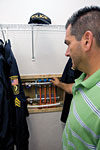
Andrew Dow, owner of Amerikool, goes over the heating system description with homeowner Peter Pappas.
Pappas has served on the Dracut, Mass., police force for 15 years. In 2004, he purchased some property beside a 75-acre, spring-fed lake and selected a lot for his new home. After months of online research and conversations with industry professionals, Pappas and his wife Kathy had a vision for their new home. Given their interests in green building and energy-efficient mechanical systems, the couple decided to act as their own general contractor, subbing out specific tasks as needed. In July 2009, nearly 13 months after breaking ground, the Pappas family moved into their new home.
“Building the house ourselves saved around $50,000 on the project,” said Pappas. “We ended up with exactly what we wanted.” In addition to the 4,200 square feet of living space, the full basement includes another 2,000 square feet - an area that includes a large mechanical room.
“We chose our subs with care,” Pappas added. “One of the best choices we made was hiring Andrew Dow, president of Dracut-based Amerikool.”
With Dow’s help, the Pappas family settled on a mechanical plan that incorporated abundant use of radiant heat, water-to-water and water-to-air geothermal systems, and solar hot water - all nestled comfortably inside a super-insulated building envelope.
HVAC EXPERTISE ON TAP
“I talked to quite a few mechanical contractors in the area before choosing one,” said Pappas. “It was clear that a home design with integrated geothermal and solar was uncharted waters for most of them. Few were interested in taking on the project. But Andy was inspired by the plan, and the match was a good one. He really grabbed the bull by the horns on this project.”Dow founded Amerikool in 1993 and has been doing residential and light commercial HVAC ever since. Serving an area 100 miles around Dracut, the company installs several solar and geothermal systems each year.
“For Peter and Kathy, energy efficiency and dependability were top priorities when it came to their HVAC system,” said Dow. To develop the system, Dow and the Pappas worked with Matt and Martin Orio of Water Energy Distributors Inc. and Tim Eaton of manufacturer’s rep Emerson-Swan.
When Martin Orio and his brother Matt got wind of the Pappas job, they made a compelling argument for some outside-the-box thinking. With their input, Pappas decided to go with two stacked, 3-ton ClimateMaster water-to-water geothermal systems to heat and cool the house. In lead-lag fashion, the systems alternate duty, or join forces whenever needed, as the home’s 11 thermostats (seven radiant zones and four ducted, hydro-air zones) call for heating or cooling. An 80-gallon, stone-lined indirect water tank is the source of thermal mass.
In the heating mode, the ClimateMaster water-to-water geo systems and small, backup boiler use the indirect tank as their “thermal target.” Btus are exchanged through an internal coil to the tank’s mass, hot water on tap for the Pappas’ extensive heating system.

Joe Milinazzo, technician at Amerikool, checks that all flange bolts are tight on the many Taco circulators at the Pappas’ residence.
POLICING BTU AND SYSTEM CIRCULATION
Smartly connecting the geo and boiler systems for the home’s main zone is an iSeries mixing valve with adjustable reset ratio, Taco’s newest zone valve with integrated outdoor reset. “The great room and connected dining area, with lots of windows, was a challenge,” explained Dow, “but we solved it easily with the iValve.”For areas with large heat loss or gain, the valve links to an outdoor reset sensor and fine-tunes indoor comfort and system efficiency by varying water temperature to specific interior spaces.
Taco zone controls and 15 all-brass, 00R, three-speed circulators easily manage the home’s radiant and hydro-air zones. Another brass Taco circulator was installed with a dedicated return line for continuous circulation of domestic hot water.
Dow also chose to tap the geo systems as chillers for summer cooling. “It was a very cool, sensible approach to extending the geo system’s tour of duty, availing cool water in the summer, targeting the tank’s volume first, then sharing it through well-insulated lines to two commercial fan coil units, each with a condensate drain pan,” explained Martin Orio. “There’s a 4-ton unit in the basement and a 3-ton unit on the second floor. It handles the home’s cooling needs easily.”

Peter and Kathy Pappas review plans for their new home in Dracut, Mass.
DEVIL'S IN THE DETAILS
“For the hydro-air systems, we installed mechanical dampers at the end of each duct run, each activated by a T-stat,” added Dow. Then, each fan coil unit has a digital bypass damper that modulates on demand and even interacts with the central ERV. The digital bypass damper senses duct pressure. If only one zone calls for cooling, it doesn’t get the force of 4 full tons.“The Orios and Tim Eaton really came to our rescue on this one. In the process we learned a lot about the incredible flexibility of water-to-water geo,” said Dow.
“Although it’s an option, we haven’t needed to use the hydro-air system in winter,” said Pappas. “The radiant is so well zoned, it just hasn’t been necessary.”

Dow checks final operational adjustments to the ClimateMaster water-to-water geothermal heat pumps.
The home’s entire slab is poured over Watts Radiant PEX tubing, heating the basement. On the first floor, a 1½-inch layer of light-weight gypcrete was poured over more RadiantPEX tubing. Watts Radiant’s Onix, a flexible EPDM rubber tubing, was stapled into the joist bays of the 1,100-square-foot second floor.
Down in the basement, all of the radiant heat circuits begin and end at Watts manifolds. The system’s circulation strategy was mapped out by Eaton. He drew up the radiant plans and provided input on system components.

Sgt. Peter Pappas served as his own land developer and general contractor for his new low-impact home.
KEEPING THE BTUs WHERE THEY BELONG
Pappas also went beyond the norm when it came to insulating his new home. “We don’t have any plans to move out, so I wanted to do everything right,” he said.The cathedral areas of the roof were sprayed with 6 inches of foam insulation, with an R-value of 7 per inch. The attic area was insulated with a blown-in R60 blanket.
Inside the walls of the house, blown-in batting [BIB] technology was put to use. Outside the walls, 1½-inch-thick sheets of rigid insulation were hung before stucco was applied or dirt was backfilled. The Styrofoam prevents thermal bridging across the 2-by-6-inch studs.
In the basement, the perimeter of the geo-to-radiant slab is outlined with more rigid insulation. “Not many people know it, but more energy escapes from a slab within the first 3 feet of the home’s exterior walls than anywhere else across the floor,” explained Pappas.
The home’s Paradigm windows are all triple-pane, krypton gas-filled, low-E glass. Their U-value is .17, which equates to R6 by insulation standards, extremely good for windows of standard thickness.
“I went around the house with a caulk gun and sealed it up tight,” said Pappas. Advanced Building Analysis LLC (ABA), an energy auditing firm based in Amesbury, Mass., assessed the home when it was completed. After conducting a blower door test resulting in 3.5 ACH @ 50 pascals, and performing a full analysis of the home, ABA gave the house a HERS (Home Energy Rating System) index of 42. While a net zero-energy home scores a HERS index of zero, the average new home in America today scores 85, which is also the minimum needed to meet Energy Star certification.
“Pulling in the services of an energy consultant early in a project is the best way to get the most value out of the relationship,” explained Paul Panish of ABA. “In order to qualify for Energy Star, consultants must be brought in while all insulation is still visible.”

At the heart of the Pappas’ HVAC system are two stacked, 3-ton ClimateMaster water-to-water geothermal systems.
UP ON THE ROOF
Mounted above the home are two 30-tube solar panels. The vacuum tube’s glycol supplies the energy needed to heat a 60-gallon stainless steel, indirect water heater to meet the Pappas’ domestic hot water needs. The space heating system and domestic hot water supply are both backed up by a 120 MBH LP-fired condensing boiler. “The systems have worked great. Last winter - from November through March - we paid about $900 for LP gas and all electricity,” said Pappas.“With the tax credits available at the time, we received $30,000 for the solar and geo,” Pappas concluded. “I really wanted to incorporate a photovoltaic array as well, but even with the federal and state incentives, it was just too much money. That’s a project for down the road.”

The Pappas’ new home incorporates radiant heat, water-to-water and water-to-air geothermal systems, and solar hot water.
Sidebar: On Guard
Andrew Dow, president of Dracut, Mass.-based Amerikool, gravitates toward smart technology. “On the Pappas’ job, ounce for ounce, this little Taco mixing valve is as smart as they come,” he said.Taco’s new microprocessor-based iSeries mixing valves is designed to regulate and easily vary hydronic system water temperatures. The device is now available in a three-way union configuration.
Dow chose the iSeries-R for use at the Pappas home; it’s linked to an outdoor reset sensor to fine-tune indoor comfort in their great room and dining area by varying water temperature to the home’s finickiest radiant zone. “If an installation includes spaces with high solar gain, or areas that lose heat quickly, the valve automatically provides warmer or cooler supply temperatures,” he said.
With an adjustable reset ratio and maximum and minimum water temperatures, the iSeries can be used for many different types of systems, including conventional high temperature systems, in-slab radiant, remote injection loops, or staple-up radiant systems that require higher start-up temperatures. The new three-way iValve with union connections makes for an easy change-out of any thermostatic mixing valve.
Publication date:02/14/2011

Report Abusive Comment